陳浩仁
HAU-REN, CHEN
Tel: (05)2720411 ext. Office 66503 Lab 61513
Fax: (05)2722871
Email: biohrc@ccu.edu.tw
- B.S., National Taiwan University, Agricultural Chemistry, 1985
- M.S., National Taiwan University, Institute of Agricultural Chemistry, 1987
- Ph.D., National Yang-Ming University, Institute of Microbiology and Immunology, 1998
- 2012.8-present Associate Professor, Department of Life Science, National Chung Cheng University
- 2002.2- 2012.7 Assistant Professor, Department of Life Science, National Chung Cheng University. Replication, infection and pathogenesis mechanisms of positive-strand RNA viruses.
- 2000.11-2002.1 Postdoctoral Fellow, with Dr. Paul Ahliquist, Institute for Molecular Virology, University of Wisconsin at Madison Purification of the RNA-dependent RNA polymerase complex of Flock House Virus (FHV) from yeast mitochondria.
- 1998.9-2000.10 Postdoctoral Fellow, with Dr. Soo-Chen Cheng (鄭淑珍), Institute of Molecular Biology, Academia Sinica. Characterization of protein factors in the Prp19p-associated complex.
- 1991.9-1998.8 Ph.D. Student, with Dr. Soo-Chen Cheng (鄭淑珍), Institute of Microbiology and Immunology, National Yang-Ming University. Establishment of genetic system to identify novel mRNA splicing factors in yeast.
- 1989.7-1991.8 Research Assistant, with Dr. Soo-Chen Cheng (鄭淑珍), Institute of Molecular Biology, Academia Sinica. Studies on mRNA splicing factors in yeast using biochemical approaches.
- 1987.7-1989.6 2nd Lieutenant, Military Service in Army.
- 1985.9-1987.6 Graduate Student, with Dr. Hsien-Yi Sung (宋賢一) and Jong-Ching Su (蘇仲卿), Laboratory of Biochemistry, Institute of Agricultural Chemistry, National Taiwan University. Research on carbohydrates metabolism in rice.
- 1984.9-1985.8 Undergraduate Student, with Dr. Hsien-Yi Sung (宋賢一) and Jong-Ching Su (蘇仲卿), Laboratory of Biochemistry, Department of Agricultural Chemistry, National Taiwan University. Research on enzyme purification in plants.
RNA病毒複製機轉之研究
Aim #1 登革熱病毒(Dengue virus)
登革熱病毒是屬於黃熱病毒科中黃熱病毒屬的一員,為正向單股的RNA病毒,其RNA基因組長度大約有11Kb。當病毒感染到宿主細胞後可轉譯出一條多蛋白前趨物,此多蛋白前趨物會被病毒本身或宿主細胞的蛋白酶作用而形成十個成熟的病毒蛋白。在這些病毒蛋白中,核心蛋白屬於結構蛋白,主要的功能是在病毒複製時正確地包覆登革熱病毒的RNA基因組。
雖然登革熱病毒的複製主要在宿主細胞的內質網上,但根據之前研究觀察指出,核心蛋白除了會進入到宿主細胞的細胞質,另外還會出現在細胞核並聚集於核仁內,這意味著核心蛋白不只是病毒的結構蛋白,在宿主細胞當中可能還扮演著其它的角色與功能,然而目前仍不甚清楚。
為了進一步了解核心蛋白在宿主細胞中的其它功能,實驗室先前利用酵母菌雙雜合系統,以第二型登革熱病毒核心蛋白為餌篩選出會與其相互結合的宿主蛋白,而hTAF7是其中之一。我們已經利用酵母菌雙雜合系統、共免疫沉澱法及GST親和力分析法來進一步證明登革熱病毒核心蛋白與hTAF7的結合作用。
另外,我也利用上述三種方法,找出登革熱病毒核心蛋白與hTAF7之間相互結合的區域。其中,核心蛋白的N端序列與C端序列是與hTAF7相互結合的必要區域,而hTAF7中央區域則是能與核心蛋白結合的重要位置。我們目前正利用RNA聚合酶依賴型報導載體來評估核心蛋白是否具有調控細胞轉錄的功能,以及其與hTAF7交互作用對於細胞轉錄調控之影響。
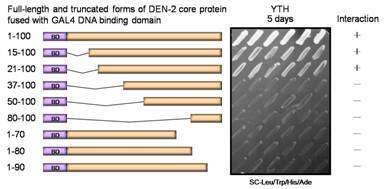
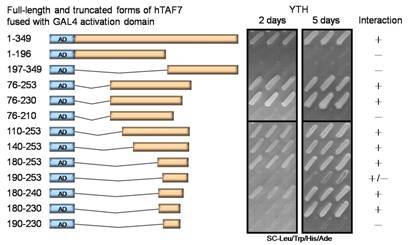
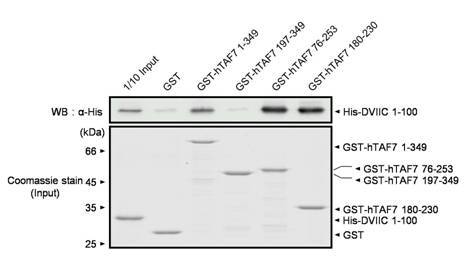

Aim #2 腦神經壞死性病毒(Nervous Necrosis Virus, NNV)
NNV屬於野田病毒科(Nodaviridae)的betanodavirus屬,是最小的動物病毒之一,屬於核醣核酸病毒。其病毒顆粒大小約25~30微米左右,是無套膜的二十面體,遺傳物質為兩條正向(positive-sense)單股的RNA,分別稱為RNA1及RNA2。兩條基因體RNA之5’端皆具有帶帽結構(capping),而3’端沒有poly(A)的結構。
RNA1約為3.1 kb所產生的蛋白質是RNA聚合酶(RNA-depend RNA polymerase, RdRp),為病毒複製時所必須的蛋白質。在病毒基因體進行複製的時候,RNA1的3’端會產生次基因體(subgenomic)RNA3,轉譯生成B2蛋白質以抑制宿主之RNA干擾機制(RNA interference),並且可以幫助病毒RNA的累積。RNA2約1.4kb,可以轉譯出稱為α蛋白的病毒殼體蛋白前趨物(precursor of viral capsid protein ),α蛋白經蛋白酶的切割後成為組成病毒的殼體蛋白。
有趣地,在感染NNV病毒或者轉染殼體蛋白α的SB和Cos-7細胞中,皆可以發現殼體蛋白α位於細胞核內,而且可以進入核仁的位置,可是對α蛋白為什麼要進入核內之生理意義並不清楚。既然一些病毒中殼體蛋白往往不只扮演病毒的外殼蛋白,更具有多種的功能,例如C型肝炎病毒(Hepatitis C Virus, HCV)或登革熱病毒(Dengue virus, DV)的殼體蛋白也可以在宿主細胞之核內被發現,且跟一些宿主蛋白交互作用,進而影響到病毒的生活史或者調控宿主細胞的基因表現。
因此我們以神經壞死性病毒殼體蛋白為餌,利用酵母菌雙雜合系統篩選出許多與殼體蛋白有交互作用的宿主蛋白,其中之一是人類RNF2蛋白(hRNF2)。經過進一步研究,此產物是RNF2蛋白之選擇性剪接產物(alternative splicing, hRNF2S)。意外地,殼體蛋白能與選擇性剪接產物hRNF2進行交互作用,但全長的hRNF2卻不能。而且hRNF2S是透過其N端與殼體蛋白進行交互作用。
由於魚類神經壞死性病毒主要是感染魚類,我們也已選殖出點帶石斑魚之RNF2蛋白(OsgRNF2),並且利用酵母菌雙雜合系統、GST親和力分析法、共免疫沉澱法以及免疫螢光染色分析證明NNV殼體蛋白同樣地會與石斑魚RNF2蛋白有交互作用。目前我們正進一步研究此交互作用所扮演的生理功能。
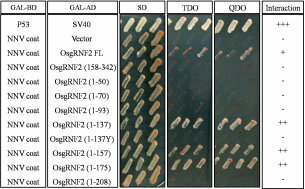
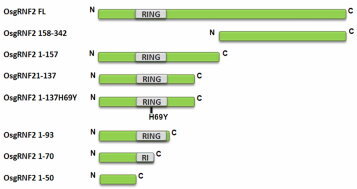
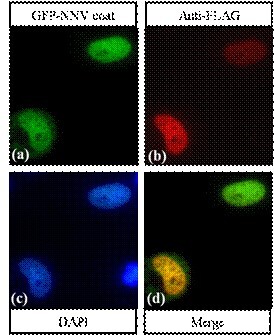
口腔癌之標誌蛋白鑑別與相關研究
口腔鱗狀細胞癌(Oral squamous cell carcinoma, OSCC)為台灣嚴重之腫瘤疾病之一,是長期嚼食檳榔、抽煙、喝酒族群中常見之惡性腫瘤。我們藉由蛋白質體學的方法分析正常人口腔鱗狀細胞及兩株惡性度不同口腔鱗狀細胞癌細胞株(OC2與OCSL),全面找尋並鑑別出與腫瘤相關的蛋白質
初步的研究結果鑑別出十一個可能蛋白質,其中六個蛋白質在一般口腔鱗狀細胞癌OC2表現較高,而有五個蛋白質在高度惡性口腔鱗狀細胞癌OCSL表現較高,這些蛋白質有些在過去的研究中已經被證實與癌症有相關聯。我們針對其中的GRP78進一步研究,經由西方墨點檢驗,比較不同口腔鱗狀細胞癌細胞株中之變化,及用免疫組織化學染色檢驗口腔鱗狀細胞癌病患組織之現況,皆顯示有統計上之差異。這些相關蛋白質未來有機會運用在口腔癌腫瘤篩檢、腫瘤復發監測,及其他相關之研究。
目前,我們正進一步評估這些蛋白對口腔癌的作用機轉。
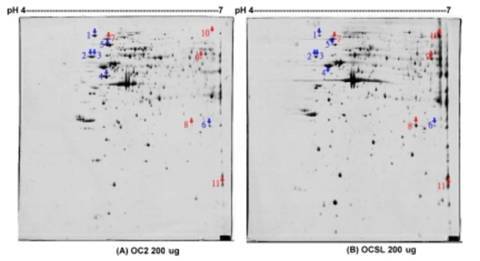
- 2006 九十四學年度中正大學全校優良導師獎
- 2006 九十四學年度中正大學教師優良教學獎
- 1998 Award of outstanding merit and high scholastic achievement in medical and pharmaceutical research sponsored by Wang Ming-Ning Memorial Foundation (王民寧優秀論文競賽獎)
- 1998 Award of excellent Ph. D. thesis sponsored by Dr. Chien-Tien Hsu (徐千田優秀論文競賽獎).
- Lee, Y.-R., Wu, W.-C., Ji, W.-T., Chen, J.Y.-F., Cheng, Y.-P., Chiang, M.-K., and Chen, H.-R. (2012) Reversine suppresses oral squamous cell carcinoma via cell cycle arrest and concomitantly apoptosis and autophagy. Journal of Biomedical Science 19:9
- Nimje, V. R., Chen, C.-Y., Chen, H.-R., Chen, C.-C., Huang, Y.-M., Tseng, M.-J., Cheng, K.-C., & Chang, Y.-F. (2012) Comparative bioelectricity production from various wastewaters in microbial fuel cells using mixed cultures and a pure strain of Shewanella oneidensis. Bioresour. Technol. 104:315-323.
- Chiang, W.-F., Ho, H.-C., Chang, H.-Y., Chiu, C.-C., Chen, Y.-L., Hour, T.-C., Chuang, S.-J., Wu, Y.-J., Chen, H.-R., Chen, J.-H., Liu, S.-Y., Lu, C.-L. and Chen, J. Y.-F. Overexpression of Rho GDP-dissociation inhibitor alpha predicts poor survival in oral squamous cell carcinoma. Oral Oncology 47: 452-458.
- Nimje, V.-R., Chen, C.-Y., Chen, C.-C., Tsaib, J.-Y., Chen, H.-R., Huangd, Y.-M., Jean, J.-S., Chang, Y.-F. and Shih, R.-C. Microbial fuel cell of Enterobacter cloacae: Effect of anodic pH microenvironment on current,power density, internal resistance and electrochemical losses. International Journal of Hydrogen Energy 36 (17):11093-11101.
- Nimje, V. R., Chen, C.-Y., Chen, C.-C., Chen, H.-R., Tseng, M.-J., Jean, J.-S. & Chang, Y.-F. (2011) Glycerol degradation in single-chamber microbial fuel cells. Bioresour. Technol. Feb; 102, 2629-2634.
- Jyoti Maity, Lin, T.-J., Cheng, P.-H., Chen, C.-Y., Reddy, A.-S., Atla, S.-B., Chang, Y.-F., Chen, H.-R., Chen, C.-C. Synthesis of brushite particles in reverse microemulsion of biosurfactant, surfactin. International Journal of Molecular Sciences 12(6):3821-3830.
- Chen, H.-R., Chen, C.-C., Reddy, A. S., Chen, C.-Y., Li, W. R., Tseng, M.-J., Liu, H.-T., Pan, W., Maity, J.P. & Atla, S.B. (2011) Removal of mercury by foam fractionation using surfactin, a biosurfactant. Int. J. Mol. Sci. 12:8245-8258.
- Huang, T.-T., Chen, J. Y.-F., Tseng, C.-E., Su, Y.-C., Ho, H.-C., Lee, M.-S., Chang, C.-T., Wong, Y.-K. and Chen, H.-R. (2010) Decreased GRP78 protein expression is a potential prognostic marker of oral squamous cell carcinoma in Taiwan. J Formos Med Assoc 109,326-337.
- Tseng, M.-Y., Liu, S.-Y., Chen, H.-R., Wu, Y.-J., Chiu, C.-C., Chan, P.-T., Chiang, W.-F., Liu, Y.-C., Lu, C.-Y., Jou, Y.-S. and Chen, J. Y.-F. (2009) Serine protease inhibitor (SERPIN) B1 promotes oral cancer cell motility and is over-expressed in invasive oral squamous cell carcinoma. Oral Oncol 45, 771-776.
- Chen, J. Y.-F., Hung, C.-C., Huang, K.-L., Chen, Y.-T., Liu, S.-Y., Chiang, W.-F., Chen, H.-R., Yen, C.-Y., Wu, Y.-J., Ko, J.-Y. and Jou, Y.-S. (2008) Src family kinases mediate betel quid-induced oral cancer cell motility and could be a biomarker for early invasion in oral squamous cell carcinoma. Neoplasia 10, 1393-1401.
- Liu, S.-Y., Chen, Y.-T., Tseng, M.-Y., Hung, C.-C., Chiang, W.-F., Chen, H.-R., Shieh, T.-Y., Chen, C.-H., Jou, Y.-S. and Chen, J.Y.-F. (2008) Involvement of microtubule-associated protein 2 (MAP2) in oral cancer cell motility: A novel biological function of MAP2 in non-neuronal cells. Biochem. Biophys. Res. Commun. 366, 520-525.
- Van Wynsberghe, P.M., Chen, H.-R. and Ahlquist P. (2007) Nodavirus RNA replication protein A induces membrane association of genomic RNA. J.Virol. 81, 4633-4644.
- Chen, C.-H., Yu, W.-C., Tsao, T. Y., Wang, L. Y., Chen, H.-R., Lin, J.-Y., Tsai, W.-Y. and Cheng, S.-C. (2002) Functional and physical interactions between components of the Prp19-associated complex. Nucleic Acid Res. 30, 1029-1037.
- Chen, C.-H., Tsai, W.-Y., Chen, H.-R., and Cheng, S.-C. (2001) Identification and characterization of two novel component of the Prp19p-associated complex, Ntc30p and Ntc20p. J. Biol. Chem. 276, 488-494.
- Sai, W.-Y., Chow, I.-T., Chen, H.-R., Huang, K.-T., Hong, R.-I., Jan, S.-P., Kuo, N.-Y., Tsao, T.-Y., Chen, C.-H. and Cheng, S.-C. (1999) Cef1p is a component of the Prp19p-associated complex and essential for pre-mRNA splicing. J. Biol. Chem. 274, 9455-9462.
- Chen, H.-R., Tsao, T.-Y., Chen, C.-H., Tsai, W.-Y ., Her, L.-S., Hsu, M.-T. and Cheng, S.-C. (1999) Snt309p modulates interactions of Prp19p with its associated components to stabilize a protein complex essential for pre-mRNA splicing. Proc. Natl. Acad. Sci. USA 96, 5406-5411.
- Chen, H.-R., Jan, S.-P., Tsao, T.- Y., Banroques Josette and Cheng S.-C. (1998) Snt309p, a component of the Prp19p-associated complex that interacts with Prp19p and associated with the spliceosome simultaneously with or immediately after dissociation of U4 in the same manner as Prp19p. Mol. Cell. Biol. 18, 2196-2204.
- Chen, H.-R., Su, J.-C. and Sung, H.-Y. (1996) Mutation mechanism of some rice endosperm mutants elucidated by a comparative study of carbohydrate constituents. Proceedings of the National Science Council, ROC 20(1), 6-13.
- Chen, H.-R., Hsu, M.-T. and Cheng, S.-C. (1995) Spheroplast preparation facilitates PCR screening of yeast sequence. BioTechniques 19, 744-747.
- Tarn, W.-Y., Hsu, C.-H., Huang, K.-T., Chen, H.-R., and Kao, H.-Y., Lee, K.-R. and Cheng, S.-C. (1994) Functional association of essential splicing factor(s) with PRP19 in a protein complex. EMBO J. 13, 2421-2431.
